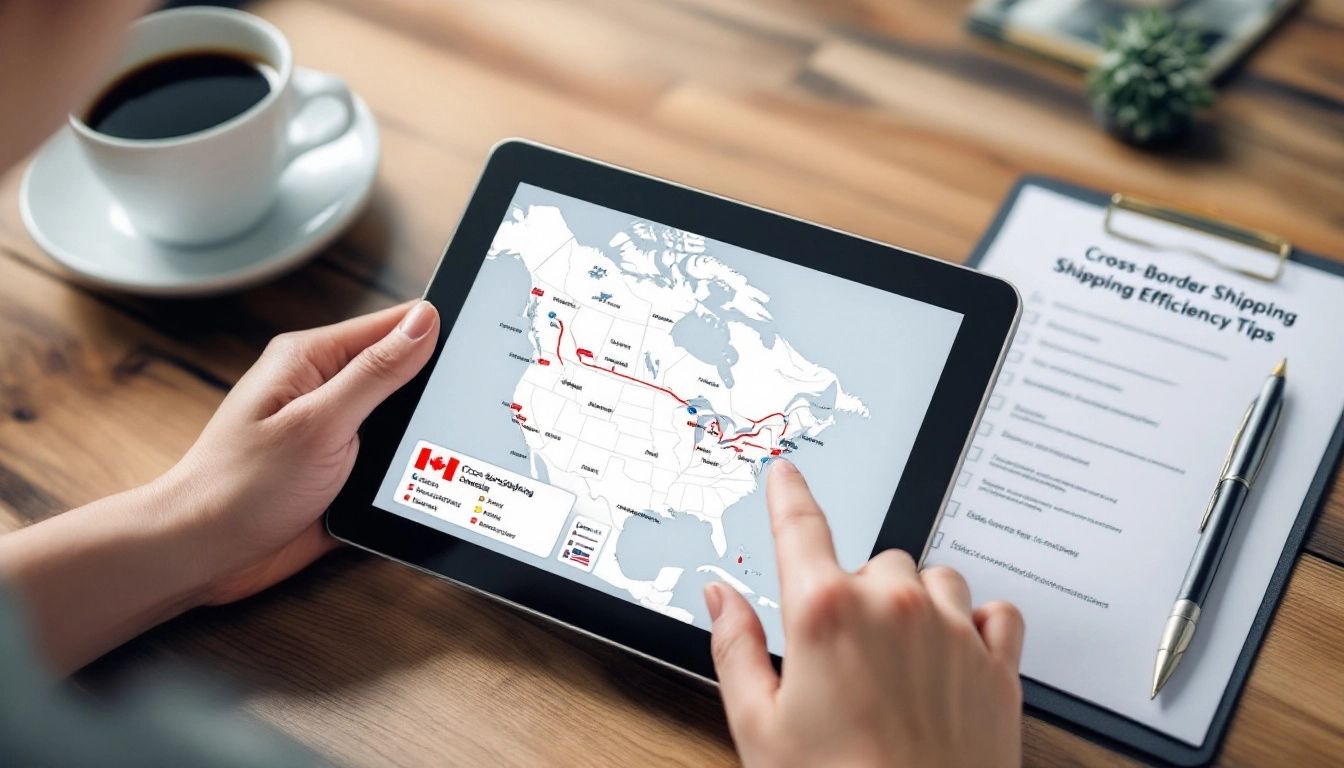Overview of Shipping Between US and Canada
The US and Canada share the world’s longest international border, stretching over 5,525 miles. This closeness, combined with strong economic ties, makes shipping between these nations a vital part of the North American economy. Each day, roughly $2.6 billion worth of goods crosses this border, showing the powerful trade relationship between the two countries.
However, shipping between the US and Canada isn’t as simple as crossing a line on a map. It involves understanding a web of regulations, documentation, and logistical factors. Businesses must grasp these complexities to thrive in the cross-border marketplace.
Whether dealing with the automotive industry, technology sector, or consumer goods market, efficient and affordable shipping is critical. Selecting suitable shipping methods, understanding customs regulations, and handling potential delays can significantly impact your bottom line.
Customs and Documentation Requirements
While shipping between the US and Canada benefits from a close relationship, it’s still a border crossing, which means paperwork! Accurate documentation is crucial to prevent delays and ensure timely delivery.
First, you’ll need a Commercial Invoice or Canada Customs Invoice (CCI). This document acts as a passport for your goods, detailing everything about the transaction: the shipped items, the seller and buyer, and the cost.
Next is the Bill of Lading (BOL), a contract between you and the carrier. It outlines key details like the freight’s description, weight, and destination, acting as a roadmap for your shipment.
Then we have the Certificate of Origin, verifying where your goods were produced. It’s not always required for US-Canada shipments, but it’s essential if you want to benefit from the USMCA trade agreement and potentially get reduced or even waived duties.
Navigating customs paperwork might seem daunting, but an experienced customs broker can be a lifesaver. They’re experts in this field, ensuring your documents are accurate and compliant with all regulations. They’ll act as your advocate, helping you sidestep costly errors and get your goods across the border smoothly.
Shipping Methods and Carriers

You have options when shipping between the US and Canada, each with pros and cons regarding speed, cost, and practicality.
Truck Freight dominates for its flexibility and extensive reach in both countries. You can choose between: Full Truckload (FTL): Ideal for large shipments that fill an entire trailer, offering direct delivery and faster transit times.Less-than-Truckload (LTL): Perfect for smaller shipments that don’t require a full truck, saving costs by consolidating goods from multiple shippers.
Rail Freight is a budget-friendly choice for large shipments traveling long distances, particularly bulk goods. It’s slower but often more environmentally friendly.
Air Freight is the fastest option, perfect for time-sensitive and valuable shipments, but it comes with a higher price tag.
Sea Freight, while not the first choice for everyone, plays a role in US-Canada shipping, especially between coastal cities. It’s slower but cost-effective for large, non-urgent shipments.
Now, about the major carriers. You’ll find big names like FedEx, UPS, and DHL, alongside specialized cross-border carriers. For US-Canada shipping expertise, a company like Abound Transport stands out. They specialize in open deck shipping, handling everything from standard freight to oversized loads requiring special trailers and permits.
Choosing the right carrier and shipping method requires balance. Consider your priorities: speed, cost, shipment size, and the level of specialized service you need. Research, compare quotes, and don’t hesitate to ask questions.
Costs and Pricing Considerations
Shipping between the US and Canada, while seemingly straightforward due to their proximity, involves various costs that can impact your budget. Understanding these costs and their influencing factors is crucial for informed decisions.
Factors Affecting Shipping Costs:
Distance: Longer distances equal higher fuel consumption and labor costs, directly impacting shipping rates.
Shipment Weight and Dimensions: Heavier and bulkier shipments need more space and resources to transport, leading to increased costs.
Shipping Method: Each method (truck, rail, air, sea) has its own pricing structure. Air freight is generally the most expensive, while sea freight is usually the most economical for large, non-urgent shipments.
Fuel Prices: Fluctuating fuel costs are a major factor in shipping rates, especially for truck and air freight.
Customs Duties and Taxes: These vary depending on the goods and their value, adding to your overall expenses.
Insurance: Protecting your goods against damage or loss during transit is vital, and insurance costs depend on the shipment’s value.
Additional Costs to Consider:
Handling Fees: Warehousing, loading, and unloading services often have associated fees.
Special Handling Requirements: Fragile, hazardous, or temperature-sensitive goods may require special handling and packaging, incurring additional costs.
Delivery Area Surcharges: Remote or hard-to-reach locations may be subject to extra fees.
For accurate shipping costs, request quotes from multiple carriers. Provide detailed shipment information, including weight, dimensions, destination, and special requirements. By understanding the cost breakdown and comparing options, you can find the most cost-effective solution for your US-Canada shipping needs.
Regulations and Restrictions
Before shipping anything between the US and Canada, ensure you’re not running into problems with prohibited items. Both countries have regulations to protect public safety, health, and security.
Some common no-nos for US-Canada shipping include:
Firearms and Weapons: This is a given. Shipping firearms and other weapons requires special permits and strict regulation adherence.
Hazardous Materials: Think explosives, flammable liquids, and toxic substances. These require special handling, packaging, and documentation.
Perishable Goods: Food items, plants, and other perishables often have specific regulations to prevent disease and pest spread.
Illegal Drugs and Narcotics: It should go without saying, but attempting to ship illegal substances across the border is a serious offense.
Beyond the obvious, there are other restricted items. For example, certain types of batteries, aerosols, and even some electronics might have limitations.
The key takeaway? Research! Check the official websites of US Customs and Border Protection (CBP) and the Canada Border Services Agency (CBSA) for up-to-date information on prohibited and restricted items. Non-compliance can lead to significant delays, fines, or even legal repercussions.
Tips for Efficient Cross-Border Shipping

Successfully navigating US-Canada shipping requires more than knowing the route. Here are practical tips for a smoother and more efficient experience:
Partner with Experts: Experience is invaluable. Find carriers and customs brokers specializing in US-Canada shipping. They’ll guide you, helping you avoid common mistakes and benefiting from their in-depth knowledge.
Embrace Technology: Utilize online tools and platforms for tracking shipments, managing documentation, and communicating with shipping partners. Many carriers offer real-time updates, giving you visibility into your shipment’s progress.
Optimize Packaging: Proper packaging is vital to protect your goods during transit. Ensure items are securely packaged and labeled, using appropriate cushioning materials. Consider sturdy, stackable boxes for easier handling.
Plan for Delays: Even with meticulous planning, unforeseen events occur. Build buffer time into your shipping schedule to account for weather disruptions, customs inspections, or unexpected traffic at border crossings.
Communicate Clearly: Maintain open communication with all parties involved, from suppliers to customers. Provide clear instructions, accurate delivery information, and address any questions or concerns promptly.
Explore Specialized Services: For businesses shipping unique or oversized cargo between the US and Canada, specialized carriers like Abound Transport Group can be invaluable. They offer the expertise, equipment, and permits to handle shipments that fall outside the norm. Whether you’re transporting machinery, construction materials, or other specialized goods, Abound Transport Group focuses on open deck shipping and cross-border expertise, ensuring your cargo is handled carefully and transported efficiently.
Ready to experience seamless cross-border shipping?
Contact Abound Transport Group today for a customized solution for your specific needs.





